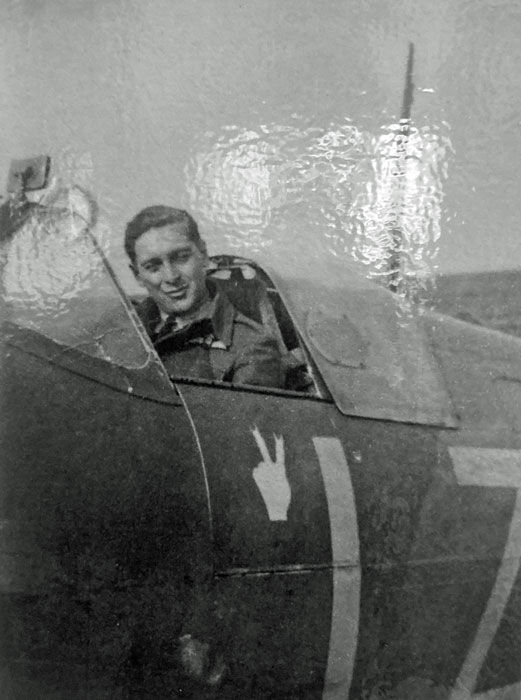
Douglas Alfred Charles Hunt’s fascination with flight began long before the Second World War — in fact, he learned to fly before he could even drive. Born in 1918, Douglas started his career as an apprentice at the Bristol Aeroplane Company. There, his engineering training and early passion for aviation set the course for what would become a remarkable flying career.
By the late 1930s, as the world edged closer to conflict, Duggie joined the Royal Air Force Volunteer Reserve (RAFVR) at Filton, Bristol, in August 1937 — one of many young men eager to master the art of flight. After just seven hours of dual instruction, he completed his first solo flight in November 1938. Further training included deck landings on HMS Furious — no small feat for a novice pilot navigating rough seas.
When war became inevitable, Duggie was posted to No. 66 Squadron in December 1939. This new unit had been formed from the expansion of No. 19 Squadron, which had grown too large. Once sufficient Spitfires were available, Duggie began flying the iconic Spitfire Mk I as part of No. 12 Group Fighter Command, responsible for defending Britain’s southern coast.
In those early wartime days, life on the airfields was a curious blend of danger and youthful mischief. Pilots were bound by camaraderie, often lightening the tension with pranks and laughter — the kind of spirit captured in The Ten Fighter Boys (1942). Duggie himself took part in one particularly infamous prank: after an evening of heavy drinking, a few pilots rolled barrels into the sleeping quarters, encircling a rather inebriated comrade’s bed …… When the unfortunate pilot awoke in the night to relieve himself, he was trapped………….in the morning, much to his dismay he found that his sheepskin flying boots were soaked!
The humour didn’t last long. On 2 June 1940, during the Battle of Britain and while protecting the final troops evacuating from Dunkirk, Duggie engaged a Ju 88 bomber and was shot down over northern France. His logbook records the experience in his own words:
“Shot up by Ju 88 and flak, glided down to 2000 feet & bailed out — aircraft on fire. Shot at by ground defences [while parachuting down] and landed about six miles east of Dunkirk. Driven to Dunkirk by two brothers [Bertaille] from Jersey — first to French HQ and then British GHQ. Met Gen. Alexander [and Sgt. Robertson – also shot down]. Boarded Admiral Wake Walker’s barge 9pm – one hour later transferred to destroyer. 3am, disembarked in Dover with final batch of BEF including General Alexander.”
That brief entry conceals an extraordinary story. As his Spitfire burned, Duggie was forced to bail out — a terrifying ordeal made worse by lack of training on when to release the cockpit harness – after inverting the aircraft -not before as he did – making bailing our more difficult. Inverting the aircraft, he managed to escape and parachuted into farmland east of Dunkirk, where local French farmers, mistaking him for a German, captured him at pitchfork point. Fortunately, two farmhands from Jersey recognised his British accent and convinced the farmers of his true identity.
Rescued by the Bertaille brothers, Duggie was driven through bombed-out roads, past the wreckage of the retreat, to British GHQ. There, amid chaos, he boarded an overcrowded barge and then a destroyer bound for Dover. During the crossing, he offered his seat to another man — moments later, a pistol accidentally discharged, hitting the very spot he had vacated.
Ever the optimist, Duggie later described the episode as his “Day Trip to Dunkirk.” He arrived back in England on 4 June 1940, just one day before the evacuations ended. A mere 48 hours later, he was back in the cockpit, flying combat sorties once again.
Over the course of his service, Duggie was credited with destroying one Heinkel He 111 and damaging another, along with destroying four planes credited as shared. Though he never reached official “ace” status, his courage, skill, and dedication were exemplary.
Later in the war, he completed the Central Flying School Instructors’ Course at Upavon and, from 1942 onward, served as a flight instructor — passing on his hard-won knowledge to the next generation of fighter pilots.
After the war, Duggie undertook the four-month Test Pilots’ Course at the Empire Test Pilots’ School, joining the Royal Aircraft Establishment (RAE) around 1946. There, he participated in post-war testing and demonstration flights, including the evaluation of captured German aircraft. Among them was the Me 163 Komet, a rocket-powered fighter that proved too temperamental to start.
In 1947, Duggie took part in the RAF’s early attempts to break the sound barrier, launching a drone from a de Havilland Mosquito off the Isles of Scilly — an experiment later commemorated through the “People’s Mosquito” project, which celebrates Britain’s wooden wonder.
From apprentice engineer to Spitfire pilot, from the battle skies over Dunkirk to the forefront of post-war aviation research, Wing Commander Douglas Alfred Charles Hunt exemplified the quiet bravery and lifelong passion for flight that defined his generation. He retired from the RAF in 1958, having finally been grounded to “fly a desk” in Whitehall.
We honour the life and legacy of Douglas Alfred Charles Hunt — Duggie — whose courage, humour, and love of flight continue to inspire.
Privacy Policy & Cookie Policy
All content © 2025 National Spitfire Project National Spitfire Project, Registered Charity No. 1158286
Website designed and built by MindWorks Marketing